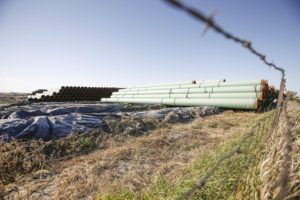Last week, Todd Stamm, vice president of the company that would operate the proposed Bakken oil pipeline, told Iowa Utilities Board members that threat assessments were created in relation to spill scenarios. According to a Des Moines Register report, those assessments include information about the scope and breadth of potential leaks.
“It is just not information that I would suggest is information that you would want to be public as far as the physical location of where that location might be,” Stamm said in answer to why such information should be kept confidential.
The proposed pipeline, under review by the Iowa Utilities Board for approval and eminent domain use, would carry about 450,000 barrels of crude oil each day from North Dakota to a distribution center in Illinois. The route cuts diagonally through Iowa, home to some of the nation’s most fertile farm land.

Local law enforcement and first responders in the affected counties would receive basic training on how to establish a perimeter around such a spill, Stamm said, but the company would dispatch workers with specialized training for cleanups. Special pipeline systems and ongoing monitoring would also be used in an effort to prevent leaks or provide early notice of spills. If a spill occurred, it would impact soil and groundwater, although Stamm and environmental advocates disagree on how long such contamination would be a factor.
A spokeswoman for Energy Transfer Partners told The Register that response plans for onshore oil pipelines are protected by federal regulations.
In September 2013, an underground pipeline operated by Tesoro Corp. in northwestern North Dakota developed a leak, which was ultimately discovered by the wheat farmer who owned the land. When contained, the spill had negatively impacted 7.3 acres with more than 20,500 barrels of oil. State and company officials kept news of the leak under wraps for 11 days, disclosing it publicly only when questioned by the press.
A year after the spill, cleanup workers remained on the land “seven days a week, 24 hours a day,” the landowner told the Associated Press. The company estimated cleanup would take two additional years.
An investigation launched by AP after the spill found about 750 “oil field incidents” had happened in North Dakota over a span of 22 months, beginning in January 2012 — not one was publicly disclosed.
The findings prompted North Dakota health department officials to begin issuing news releases on significant spills, but no automatic notification for property owners or nearby residents is in place.
North Dakota isn’t alone. In many oil-producing states, state and company officials are not required to notify the public when things go awry.

Two months ago, as I was waiting in a security line at Reagan National Airport, I happened to look up and see a billboard with a very familiar scene. Windmills standing tall above Iowa fields.
The billboard was an advertisement for Siemens, but it could have been an ad for the clean energy efforts touted by state officials.
It remains unclear to me why those same officials would want to jeopardize that carefully crafted national narrative by allowing a potentially dangerous pipeline to split our state, further pollute our water and ruin our rich soil.
The proposed pipeline offers few long-term benefits to Iowans. Once constructed, only a handful of related jobs will remain in the state. The product it carries isn’t of immediate benefit to our communities or businesses. Even so, Iowa landowners will assume a risk that could impact far more than agreed to easements — some will do so against their will.
This column by Lynda Waddington originally published in The Gazette on November 22, 2015. Photo credit: Lynda Waddington & Andy Abeyta/The Gazette
